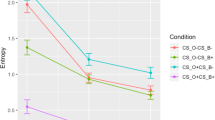Abstract
This paper reports an experimental study of a possible confound in measures of young children's phoneme awareness — that of global similarity between words. We developed two otherwise identical versions of a test of phoneme invariance (typical item, ‘which starts the same asbeak, bowl orshed?’), one version controlling for global similarity and the other not. We administered both tests to 27 kindergarten children, along with three criterion measures of early literacy skill. Three converging results supported the importance of controlling for global similarity when attempting to measure phoneme invariance: (1) the subjects attained higher scores on the uncontrolled version, and half of those passing this version (11/22), were ‘false positives’ in that they did not pass the controlled version, (2) a metric of global similarity was significantly related to the proportion of children passing an item on both versions, and (3) there was a stronger relation between the controlled version and the criterion literacy measures of spelling and decoding than was found for the uncontrolled version. The educational implications of the results are discussed.
Similar content being viewed by others
References
Australian Council for Educational Research [ACER] (1981).Recognition of initial consonant sounds test. Hawthorn, Victoria: ACER.
Bradley, L. & Bryant, P. E. (1983). Categorizing sounds and learning to read: A causal connection,Nature 301: 419–421.
Bryant, P. E., Bradley, L., Maclean, M. & Crossland, I. (1989). Nursery rhymes, phonological skills and reading,Journal of Child Language 16: 407–428.
Byrne, B. & Fielding-Barnsley, R. (1989). Phonemic awareness and letter knowledge in the child's acquisition of the alphabetic principle,Journal of Educational Psychology 81: 313–321.
Byrne, B. & Fielding-Barnsley, R. (1990). Acquiring the alphabetic principle: A case for teaching recognition of phoneme identity,Journal of Educational Psychology 82: 805–812.
Byrne, B. & Fielding-Barnsley, R. (1991a). Evaluation of a program to teach phonemic awareness to young children,Journal of Educational Psychology 83: 451–455.
Byrne, B. & Fielding-Barnsley, R. (1991b).Sound foundations. Sydney: Peter Leyden Educational Publishers.
Byrne, B. & Fielding-Barnsley, R. (1993). Evaluation of a program to teach phonemic awareness to young children: A one-year follow-up,Journal of Educational Psychology 85: 104–111.
Fox, B. & Routh, D. K. (1980). Phonetic analysis and severe reading disability in children,Journal of Psycholinguistic Research 9: 115–119.
Garner, W. R. (1974).The processing of information and structure. New York: Wiley.
Liberman, I. Y., Rubin, H., Duquès, S. & Carlisle, J. (1985). Linguistic abilities and spelling proficiency in kindergarteners and adult poor spellers. In: D. B. Gray & J. F. Kavanagh (eds.),Biobehavioral measures of dyslexia (pp. 163–176). Parkton, MD: York Press.
Liberman, I. Y., Shankweiler, D., Fischer, F. W. & Carter, B. (1974). Explicit syllable and phoneme segmentation in the young child,Journal of Experimental Child Psychology 18: 210–212.
Lundberg, I., Frost, J. & Petersen, O-P. (1988). Effects of an extensive program for stimulating phonological awareness in preschool children,Reading Research Quarterly 23: 264–284.
Rosner, J. (1975).Helping children overcome learning difficulties. New York: Springer Verlag.
Singh, S. & Woods, D. R. (1971). Perceptual structure of 12 American English vowels,Journal of the Acoustical Society of America 49: 1861–1866.
Singh, S., Woods, D. R. & Becker, G. M. (1972). Perceptual structure of 22 prevocalic English consonants,Journal of the Acoustical Society of America 52: 1698–1713.
Smith, L. B. & Kemler, D. G. (1977). Developmental trends in free classification: Evidence for a new conceptualization of perceptual development,Journal of Experimental Child Psychology 24: 279–298.
Stanovich, K. E., Cunningham, A. E. & Cramer, B. B. (1984). Assessing phonological awareness in kindergarten children: Issues of task comparability,Journal of Experimental Child Psychology 38: 175–190.
Torgesen, J. & Bryant, B. R. (1991).Screening test of phonological awareness. Austin, TX: Pro-Ed, Inc.
Treiman, R. & Baron, J. (1983). Phonemic analysis training helps children benefit from spelling-sound rules,Memory & Cognition 11: 382–389.
Treiman, R. & Breaux. (1982). Common phoneme and overall similarity relations among spoken syllables: Their use by children and adults,Journal of Psycholinguistic Research 11: 569–598.
Treiman, R. & Weatherston, S. (1992). Effects of linguistic structure on children's ability to isolate initial consonants,Journal of Educational Psychology 84: 174–181.
Yopp, H. K. (1988). The validity and reliability of phonemic awareness tests,Reading Research Quarterly 23: 159–177.
Author information
Authors and Affiliations
Rights and permissions
About this article
Cite this article
Byrne, B., Fielding-Barnsley, R. Recognition of phoneme invariance by beginning readers. Read Writ 5, 315–324 (1993). https://doi.org/10.1007/BF01027394
Issue Date:
DOI: https://doi.org/10.1007/BF01027394




